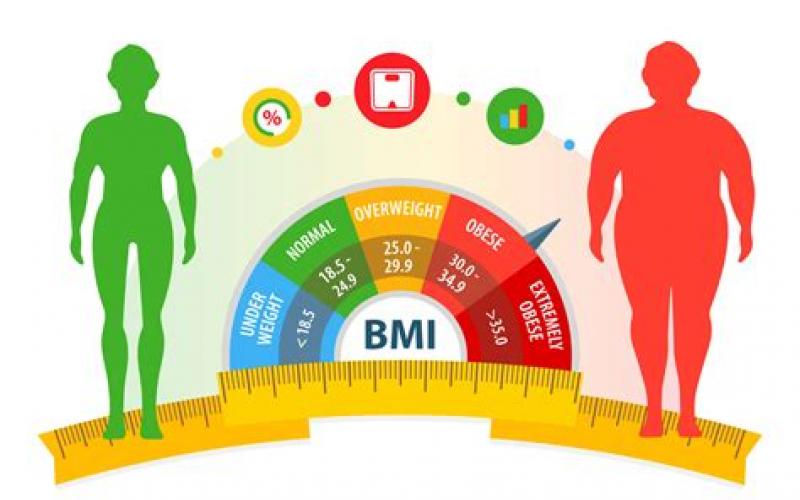
A body mass index in the range considered overweight, or even obese, is not necessarily associated with a higher risk of death, a new study has found. The research is the latest addition to a growing body of evidence that suggests BMI alone is not an accurate indicator of a person's health.
The study, published Wednesday in the journal PLOS One, assessed the relationship between BMI and the risk of death from any cause, based on data from more than 550,000 U.S. adults over an average of nine years.
The results showed no significant increase in the risk of death for those 65 years and older with BMIs between 22.5 and 34.9. The same was true for younger adults with BMIs between 22.5 and 27.4. A BMI of 25 or above is considered overweight, and 30 or above is considered obese.
BMI is calculated by dividing a person’s weight by the square of their height. For decades, it has been used to assess whether a person’s weight is “healthy” or could bring a risk of diabetes or heart disease. But many health care professionals have criticized this, saying BMI does not account for crucial factors such as body fat percentage and variations in disease risk among people of different races and genders.
Last month, the American Medical Association adopted a policy advising physicians to use additional measures — including waist circumference, fat distribution in the body, and genetic factors — to assess a patient’s health.
The study’s findings support the new guidelines, according to Dr. Aayush Visaria, an internal medicine resident at Rutgers Robert Wood Johnson Medical School and co-author of the new study.
“Our results are basically confirming a lot of other studies that have been done in recent years — not at this large of a level, but basically confirming that BMI by itself is really a poor indicator of health risk,” Visaria said.
Waist circumference, he added, may be a stronger indicator: The study compared people with equal BMIs but different waist circumferences and found that the latter was associated with a higher risk of death overall.
The study results did, however, show that participants with a BMI of 30 or more faced a greater mortality risk. Among younger adults, a BMI of 27.5 to 29.9 was also associated with a nearly 20% greater risk.
Dr. Fatima Stanford, an obesity medicine specialist at Massachusetts General Hospital who was not involved in the new research, said BMI can equate leanness with health at the expense of other important factors. Substance abuse disorders, tobacco use and disordered eating can all lead to a leaner physique, she noted, but do not mean that a person is healthy.
“The reason I keep hearing why we should use it is because it’s easy,” Stanford said. “Just because it’s easy, doesn’t mean it’s right.”
Past research has revealed issues with using BMI to assess whether an individual is obese or at risk of weight-related disease. In a 2016 study, nearly half of the participants considered overweight and 29% of those considered obese were found to be metabolically healthy, while over 30% of people with weights considered “normal” were metabolically unhealthy.
Similarly, other research Visaria presented last month indicated that people with “normal” BMIs may still be obese.
Stanford also emphasized that the BMI ranges considered overweight or obese don’t account for differences that arise among racial and ethnic groups. Some research suggests, for example, that Asian people may face a higher risk of developing metabolic diseases like diabetes and hypertension at a BMI lower than the general thresholds.
Black women, meanwhile, are often healthy at BMIs in the overweight and obese ranges, Stanford said. A 2013 study found higher BMI was not as strongly linked to mortality risk in Black Americans as it was in whites.
In the new study, the authors noted that some past studies that had found a link between BMI and higher mortality used U.S. data from the 1960s to 1990s, with mostly white participants. But non-Hispanic white people accounted for 58% of the U.S. population in 2020, compared to 85% in 1990, so those past data sets may be less applicable, Visaria said.
Participants in the new study were 69% white, 12% Black, 14% Hispanic and nearly 5% Asian — which Stanford said is comparatively a “pretty great representation.”
However, Dr. Jaime Almandoz, medical director of the Weight Wellness Program at UT Southwestern Medical Center in Dallas, pointed to a few shortcomings in the study. For one, he said, it focuses solely on the relationship between BMI and the risk of death.
“There’s so much more to life than not dying,” Almandoz, who was not involved in the new research, said. “Studies like this can be misinterpreted by saying, ‘Well, up to a BMI of 30 is fine, or ‘Up to a BMI of 35 in older adults is fine,’ but that doesn’t mean that a person is not living with Type 2 diabetes or an increased risk for heart attack, stroke, heart failure.”
According to the Centers for Disease Control and Prevention, people with BMIs of 25 or higher face an increased risk of high blood pressure and cholesterol, Type 2 diabetes and several types of cancer.
Almandoz also pointed out that the study underrepresents the share of people who are obese. About 27% of the participants had a BMI greater than 30, whereas a CDC survey estimated that 42% of U.S. adults are obese.
Visaria said that if the study had looked at participants’ fat percentages, it might have found that more than 27% were obese. But that’s precisely the problem, he added: BMI does not measure the share of body fat.
“This kind of adds to the idea that clinicians should be using different measures of body fat to diagnose obesity, not just BMI,” he said. “I think in the future these measures will become commonplace.”
source: https://www.nbcnews.com/health/health-news/high-bmi-risk-of-death-study-rcna92422






